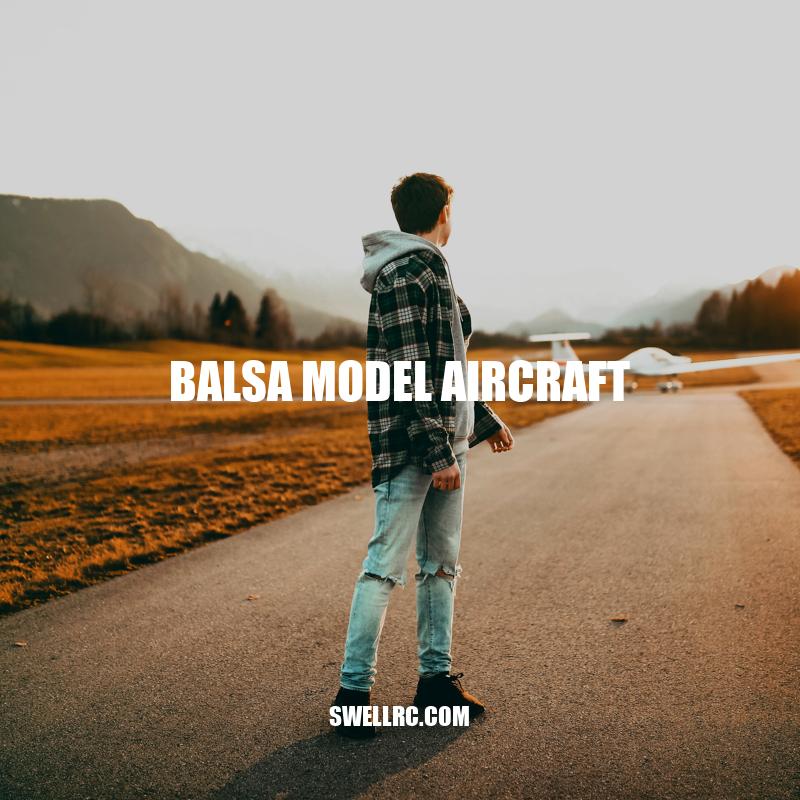Balsa Model Aircraft: Building, Flying, and Maintenance Tips
Balsa model aircraft are among the most popular types of model airplanes that people of all ages enjoy building and flying. These aircraft are miniature replicas of real planes, built using lightweight and flexible balsa wood, along with other materials like plastic, metal, and carbon fiber. The process of building and flying a balsa model aircraft is a rewarding hobby that teaches valuable skills such as attention to detail, patience, and craftsmanship. The ability to create a functioning and beautiful model airplane from scratch provides a sense of pride and accomplishment that is unmatched. Balsa model aircraft come in various shapes and sizes, ranging from smaller electric motor-powered aircraft to larger gas-powered ones. Regardless of their size, they all share the same characteristics of being lightweight, easy to control, and able to fly smoothly and gracefully. With a bit of practice and skill, the flyability and performance of balsa model aircraft can be enhanced by adjusting their balance, control surfaces, and power system. Whether building purely for the fun of it or striving to create the most realistic and advanced model airplane possible, balsa model aircraft offer an exciting and fulfilling hobby for aviation enthusiasts and model builders alike.
Benefits of Building Balsa Model Aircraft
Building balsa model aircraft is more than just a fun and rewarding hobby. There are several benefits to this activity, including:
- Improving attention to detail and fine motor skills
- Learning about the principles of flight and aerodynamics
- Developing patience and a sense of discipline while working through the building process
- Creating a sense of accomplishment and pride for building a functioning model airplane
- Cultivating a deeper appreciation for aviation and the art of model building
Not only do balsa model aircraft provide a fun and educational activity for builders, but they are also popular among collectors and enthusiasts. There are websites, forums, and marketplaces dedicated to sharing information, plans, and products related to balsa model aircraft. These resources offer a community and avenue for builders to connect, learn from each other, and showcase their work. Additionally, there are many different types of balsa model aircraft kits and plans available for purchase, ranging in price and complexity, making this hobby accessible to anyone interested.
What are the advantages of using models such as balsa wood gliders over full size prototypes?
Using models such as balsa wood gliders offer several advantages over full-size prototypes. Firstly, balsa wood gliders are much cheaper to produce, making them highly accessible to engineers and hobbyists alike. Unlike full-size prototypes, balsa wood gliders are much smaller and can be easily transported, which makes them convenient for testing and experimentation in a variety of locations. Furthermore, because of their smaller size, balsa wood gliders can be quickly and easily modified and adjusted, allowing engineers to refine their designs iteratively without breaking the bank.
Another advantage of using balsa wood gliders over full-size prototypes is that they are safer and more environmentally friendly. Full-size prototypes are often made of heavy and expensive materials like metal, which can be both dangerous to work with and difficult to dispose of safely. Balsa wood gliders, on the other hand, are lighter and generally non-toxic, which makes them easier to handle and less harmful to the environment.
Finally, balsa wood gliders provide an effective platform for testing and refining aerodynamic principles. Because of their small size and low cost, engineers and hobbyists can experiment with a wide range of wing shapes, airfoils, and control systems, allowing them to optimize their designs for maximum efficiency and performance. Models like balsa wood gliders offer a viable alternative to full-size prototypes, providing a safe, affordable, and effective testing platform for engineers and hobbyists alike.
How to Build Balsa Model Aircraft
Building a balsa model aircraft can seem daunting, but with the right tools, materials, and instruction, it can be a rewarding experience. Here are some steps to follow when building your own balsa model aircraft:
Materials and Tools:
- Balsa wood sheets and planks
- Balsa cement
- Paint / brush
- Trim covering and decals
Step-by-step instructions:
- Select a design plan based on your skill level and interest.
- Cut out the parts from the balsa wood sheets following the instructions on the plan or cutting your own pieces
- Assemble the fuselage, wings, and tail using balsa cement and any included hardware
- Shape, sand, and cover the model with trim and paint to your desired finish
- Add any necessary details, such as landing gear, antennas, or cockpit
- Test fly the model to verify balance, trim, and performance
Balsa model aircraft building has come a long way since the model-building craze of the 1930s. Nowadays, it’s easier to build and fly balsa model aircraft thanks to advances in technology and materials. Customization, too, has become more popular with different designs being introduced from builders who are constantly pushing the envelope of what’s possible. Also, there are plenty of websites and online communities where builders can share tips, tricks, and interesting innovations.
Check out Tower Hobbies for some great balsa model aircraft kits to get started with!
How to design a model of an aircraft?
Designing a model of an aircraft is a meticulous task that involves various technicalities. Here are a few steps that can help you design a model aircraft:
1. Research: Before starting the design process, do some research on the type of aircraft you want to design. Study the different features, technical specifications, and unique characteristics of the aircraft.
2. Plan and Sketch: After gathering the necessary information, start planning and sketching the design of your model aircraft. You can use paper and pencil or even digital design software tools.
3. Create a Prototype: Next, create a prototype of the aircraft. Depending on the complexity of the design, it might require cardboard, foam or even 3D printing.
4. Test: After creating a prototype, test the performance and functionality of the model. Check if it flies as expected or if it needs adjustments.
5. Refine and Improvise: Based on the test results and feedback, refine and improve your design. Revise the issues and make necessary adjustments.
6. Finalize: After the refinements, finalize the design, and prepare it for the final production. Use quality materials to add the finishing touches.
In conclusion, designing a model of an aircraft is a detailed process that requires time, efforts, and patience. But with the right tools, techniques, and expertise, you can accomplish designing an innovative, creative and impressive aircraft model.
Maintenance and Care of Balsa Model Aircraft
Proper maintenance and care can ensure the longevity of your balsa model aircraft. Here are some tips to keep in mind:
Storage:
- Store your balsa model aircraft in a cool, dry place, away from direct sunlight and humidity.
- Do not store the aircraft near any chemicals, such as gasoline or solvents, which can damage the covering or soften adhesives.
Repair:
- Check your balsa model aircraft for any damage before and after each flight. Look for any cracks, warping, or other issues that need attention.
- Repair any damage using balsa cement and clamps or other tools as needed.
- Use sandpaper to smooth out any rough edges or surfaces in the aircraft.
Protection:
- Cover the aircraft with a protective film or cover to prevent damage from scratches or other abrasions. This is particularly important during transport or storage.
- Apply a waterproofing spray to the aircraft to prevent damage from moisture or humidity.
- Do not leave the aircraft exposed to extreme temperatures, such as in a parked car, as this can cause warping or cracking.
To ensure the best performance and longest lifespan of your balsa model aircraft, it’s essential to follow these maintenance tips. Another helpful resource for balsa model aircraft enthusiasts is online communities and websites where you can get advice on maintenance and repair, as well as purchase new and replacement parts. Some popular websites for balsa model aircraft include Balsa USA, SIG Manufacturing, and The Vintage Model Company.
How do you clean a model plane?
Cleaning a model plane is an essential task to maintain it in top-notch condition. After all, who wouldn’t want their hard-earned miniature aircraft to look as good as new? Whether you’re a seasoned aircraft model enthusiast or just starting, cleaning your model plane should be done with extra care.
Firstly, before starting the cleaning process, make sure to remove all the detachable parts present (e.g., wings, propeller, etc.). This will prevent any damage to them during cleaning. After that, use a soft-bristled brush or a microfiber cloth to remove any dust particles present on the external surfaces of the plane.
If your model plane is dirty, then using a mild detergent, warm water, and a soft-bristled brush can effectively remove any accumulated dirt. Make sure to avoid submerging the plane in the water as this could cause damage to the internal components.
If there are any spots or stains present, a diluted vinegar solution can be used to remove them, but be sure to test it on a small area first to avoid any possible discoloration.
Once you have finished cleaning the plane, make sure to leave it to dry completely before putting back the detachable parts. Additionally, you can apply a wax coating to the painted surfaces after the cleaning process, to help protect against any future damage and maintain a shiny appearance.
Cleaning a model plane may seem like a tedious task, but regular cleaning is key in preserving its lifespan. By following these simple steps, you can keep your plane looking spotless and ready to take off for many years to come.
Flying Balsa Model Aircraft
Flying balsa model aircraft can be an exhilarating experience, but it’s important to follow safety guidelines and precautions. Here are some tips for flying your balsa model aircraft safely:
Location:
- Choose an open area, away from trees, buildings, and other obstacles where you can fly your aircraft without any interference.
- Make sure the location is clear of people, pets, and other living creatures to avoid accidents or injuries.
- Stay away from power lines or other electrical hazards that can interfere with your aircraft’s controls.
Preparation:
- Double-check your balsa model aircraft before flying to make sure everything is in proper working order.
- Make sure the battery, if applicable, is fully charged and functional.
- Turn on the aircraft and do a quick ground check to confirm all systems are functioning properly.
- Check the weather conditions before taking off, and avoid flying in high wind or extreme heat.
Flight:
- Find the appropriate speed and altitude for your balsa model aircraft, following the instructions for your specific model.
- Keep your eyes on the aircraft at all times, and avoid distractions or other activities while flying.
- Stay in control of the aircraft, and avoid erratic movements or sudden changes in direction.
- Land the aircraft safely by approaching slowly and gently, and reducing the speed as you near the ground.
To further improve your flying skills and techniques, consider joining a local balsa model aircraft club or attending a workshop. This can help you learn from more experienced enthusiasts, and get access to special resources or tools. Some popular websites for balsa model aircraft clubs and workshops include the Academy of Model Aeronautics, the International Radio Control Aerobatics Club, and the Vintage RC Society.
Why is balsa wood good for making a model aircraft?
Balsa wood is one of the most popular materials for constructing model airplanes. This is primarily because of its unique properties. Firstly, balsa wood is lightweight. In fact, it is one of the lightest woods available, making it ideal for model aircraft which require materials that will not weigh them down. Secondly, its strength-to-weight ratio is excellent. Despite its light weight, balsa wood is deceptively strong which means it can withstand the pressure and forces exerted on a model aircraft while it is in flight. Another advantage of balsa wood is that it is easy to work with. The wood is easy to cut with a fine saw, which is important for producing those intricate pieces needed for a model airplane. Lastly, balsa wood is economical in cost and readily available, which makes it the go-to material for hobbyists and professionals alike.
Famous Balsa Model Aircraft
Balsa model aircraft are not just limited to hobbyists, but have also left a mark in history and popular culture. Here are some of the most famous balsa model aircraft:
The Guillow’s B-17 Flying Fortress:
- A replica of the famous World War II airplane, the Guillow’s B-17 Flying Fortress is known for its impressive size and detailed features.
- Many model aircraft enthusiasts consider it as one of the most challenging aircraft to assemble due to its intricate design and numerous parts.
- The Guillow’s B-17 Flying Fortress kit comes with 1/28 scale plans, with a wingspan of 45 ¾ inches and a length of 33 ½ inches.
The Spirit of St. Louis:
- The Spirit of St. Louis was the first aircraft to fly across the Atlantic Ocean, solo, non-stop from New York to Paris, with Charles Lindbergh as the pilot.
- A replica balsa model aircraft of The Spirit of St. Louis is one of the most popular model airplanes in the world, with a 28-inch wingspan and a 19-inch length.
- The model kit is designed by Guillow’s, and features high-quality balsa wood, scale details, and precise engineering.
The Fokker Dr.1:
- The Fokker Dr.1 was a World War I aircraft flown by the infamous German ace, Manfred von Richthofen, also known as the Red Baron.
- A replica balsa model aircraft of the Fokker Dr.1 is a popular choice among model airplane enthusiasts, with a wingspan of 18 inches and a length of 14 inches.
- The model kit is designed by Guillow’s and includes all the necessary materials to build a realistic and stunningly detailed replica of the aircraft.
These famous balsa model aircraft have contributed to the popularity and admiration of model aviation. Additionally, it has proven to be an educational tool in learning aviation history. Some of the best online resources for purchasing balsa model aircraft kits include websites like Tower Hobbies, SIG Mfg., and Balsa USA.
Who makes the best plane models?
When it comes to the world of plane models, there are numerous manufacturers that offer an incredible range of options. However, it can be challenging to determine who produces the “best” models. If you’re a collector or enthusiast, you may have specific preferences and criteria that factor into your definition of “best.” Some may prioritize accuracy in scale and detail, while others may seek out rare or limited-edition releases.
One brand that consistently ranks high in the eyes of collectors and enthusiasts is Gemini Jets. Based in Las Vegas, Gemini Jets has been producing high-quality die-cast aircraft models since 1998. They are known for their attention to detail and accuracy, with many of their models featuring real-world liveries, functioning landing gear, and moveable parts.
Another notable brand in the market is Herpa. Founded in Germany in 1949, Herpa has since expanded its offerings to include not only planes but also cars, trucks, and other vehicles. They specialize in 1:500 and 1:200 scale models, with an emphasis on highly detailed and accurate designs.
Other top contenders in the market include JC Wings, Phoenix Models, and Aviation 72. JC Wings offers a wide range of models at various scales, including military planes and helicopters. Phoenix Models is particularly known for their detailed and beautifully painted models of rare and lesser-known aircraft. Lastly, Aviation 72 is a smaller company based in the UK that produces modestly-priced, yet high-quality diecast models in 1:72 scale.
Ultimately, the “best” plane model brand will depend on your personal preferences and priorities. However, these brands are definitely among the top choices for collectors and enthusiasts who want high-quality, accurate models that capture the beauty and intricacy of real-world aircraft.
Conclusion
Balsa model aircraft present a fun and engaging hobby for aviation enthusiasts and beginners alike. The use of balsa wood as a primary building material brings numerous benefits to the construction of model airplanes, enabling the creation of lightweight and flexible structures. Building and flying balsa model aircraft also present a learning opportunity in craftsmanship, attention to detail, and historical significance in aviation history. The joy of building and flying these unique models can bring a sense of accomplishment and pride while providing an enjoyable and satisfying pastime.
While building balsa model aircraft requires a certain degree of skill and expertise, it is achievable through the use of instructional materials and technological aids that can be found online, in hobby stores, or through purchasing kits. The popularity of balsa model aircraft has continued to thrive, with numerous competitions and community events that showcase these unique model airplanes to the public.
In conclusion, balsa model aircraft are an exceptional hobby that provides benefits in craftsmanship, history, and a fun pastime for people of all ages and skill levels. Model aviation enthusiasts can continue to enjoy this hobby through the use of numerous materials, equipment, and resources that make the building of these airplanes enjoyable and straightforward.



